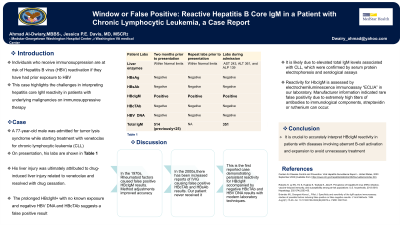Sunday Poster Session
Category: Liver
P1068 - Window or False Positive: Reactive Hepatitis B Core IgM in a Patient with Chronic Lymphocytic Leukemia, a Case Report
Sunday, October 22, 2023
3:30 PM - 7:00 PM PT
Location: Exhibit Hall

Has Audio

Ahmad Al-Dwairy, MBBS
MedStar Georgetown Washington Hospital Center
Washington, DC
Presenting Author(s)
Ahmad Al-Dwairy, MBBS1, Jessica Davis, MD2
1MedStar Georgetown Washington Hospital Center, Washington, DC; 2Washington DC VA Medical Center, Washington, DC
Introduction: Individuals who receive immunosuppression are at risk of Hepatitis B virus (HBV) reactivation if they have had prior exposure to HBV. Diagnosis of acute or chronic HBV infection relies on serological markers and HBV DNA testing. This case highlights the challenges in interpreting hepatitis core IgM reactivity in patients with underlying malignancies on immunosuppressive therapy.
Case Description/Methods: A 77-year-old male was admitted for tumor lysis syndrome while starting treatment with venetoclax for chronic lymphocytic leukemia (CLL). During his admission, his liver enzymes increased to a peak of AST 243, ALT 361, and ALP 139. He had reactive HBcIgM and negative HBV DNA, HBsAg, HBsAb, and HBcTAb. The patient had similar serologic findings two months prior when hepatitis B serologies were checked empirically before potential chemotherapy.
His liver injury was ultimately attributed to drug-induced liver injury related to venetoclax and resolved with drug cessation. Given the persistent HBcIgM+ over several weeks in a setting of negative HBV DNA, negative HBcTAb, and no known exposures, the positive HBcIgM was considered a false positive result. His total IgM was elevated at 351, up from a baseline of 36-66 before his CLL diagnosis.
Discussion: In the 1970s, false positive HBV serologic results were observed due to the influence of Rheumatoid factors on earlier testing methods. However, subsequent modifications to these methods successfully minimized the interference and improved the accuracy of the results. Recently, there have been increasing reports of altered hepatitis serologies in patients receiving intravenous Immunoglobulin, leading to positive HBcTAb and HBsAb results. Our patient had never received intravenous immunoglobulin.
This is the first reported case demonstrating persistent reactivity for HBcIgM accompanied by negative HBcTAb and HBV DNA results with modern laboratory techniques. It is likely due to elevated total IgM levels associated with CLL, which were confirmed by serum protein electrophoresis and serological assays. The manufacturer's information mentioned that elevated Immunoglobulin levels could contribute to false positive results. It is crucial to accurately interpret HBcIgM reactivity in patients with diseases involving aberrant B-cell activation and expansion. This patient population commonly receives therapies that increase risk of HBV reactivation thus accurate interpretation of HBV serologic testing is critical to monitor and treat this group appropriately.
Disclosures:
Ahmad Al-Dwairy, MBBS1, Jessica Davis, MD2. P1068 - Window or False Positive: Reactive Hepatitis B Core IgM in a Patient with Chronic Lymphocytic Leukemia, a Case Report, ACG 2023 Annual Scientific Meeting Abstracts. Vancouver, BC, Canada: American College of Gastroenterology.
1MedStar Georgetown Washington Hospital Center, Washington, DC; 2Washington DC VA Medical Center, Washington, DC
Introduction: Individuals who receive immunosuppression are at risk of Hepatitis B virus (HBV) reactivation if they have had prior exposure to HBV. Diagnosis of acute or chronic HBV infection relies on serological markers and HBV DNA testing. This case highlights the challenges in interpreting hepatitis core IgM reactivity in patients with underlying malignancies on immunosuppressive therapy.
Case Description/Methods: A 77-year-old male was admitted for tumor lysis syndrome while starting treatment with venetoclax for chronic lymphocytic leukemia (CLL). During his admission, his liver enzymes increased to a peak of AST 243, ALT 361, and ALP 139. He had reactive HBcIgM and negative HBV DNA, HBsAg, HBsAb, and HBcTAb. The patient had similar serologic findings two months prior when hepatitis B serologies were checked empirically before potential chemotherapy.
His liver injury was ultimately attributed to drug-induced liver injury related to venetoclax and resolved with drug cessation. Given the persistent HBcIgM+ over several weeks in a setting of negative HBV DNA, negative HBcTAb, and no known exposures, the positive HBcIgM was considered a false positive result. His total IgM was elevated at 351, up from a baseline of 36-66 before his CLL diagnosis.
Discussion: In the 1970s, false positive HBV serologic results were observed due to the influence of Rheumatoid factors on earlier testing methods. However, subsequent modifications to these methods successfully minimized the interference and improved the accuracy of the results. Recently, there have been increasing reports of altered hepatitis serologies in patients receiving intravenous Immunoglobulin, leading to positive HBcTAb and HBsAb results. Our patient had never received intravenous immunoglobulin.
This is the first reported case demonstrating persistent reactivity for HBcIgM accompanied by negative HBcTAb and HBV DNA results with modern laboratory techniques. It is likely due to elevated total IgM levels associated with CLL, which were confirmed by serum protein electrophoresis and serological assays. The manufacturer's information mentioned that elevated Immunoglobulin levels could contribute to false positive results. It is crucial to accurately interpret HBcIgM reactivity in patients with diseases involving aberrant B-cell activation and expansion. This patient population commonly receives therapies that increase risk of HBV reactivation thus accurate interpretation of HBV serologic testing is critical to monitor and treat this group appropriately.
Disclosures:
Ahmad Al-Dwairy indicated no relevant financial relationships.
Jessica Davis indicated no relevant financial relationships.
Ahmad Al-Dwairy, MBBS1, Jessica Davis, MD2. P1068 - Window or False Positive: Reactive Hepatitis B Core IgM in a Patient with Chronic Lymphocytic Leukemia, a Case Report, ACG 2023 Annual Scientific Meeting Abstracts. Vancouver, BC, Canada: American College of Gastroenterology.
